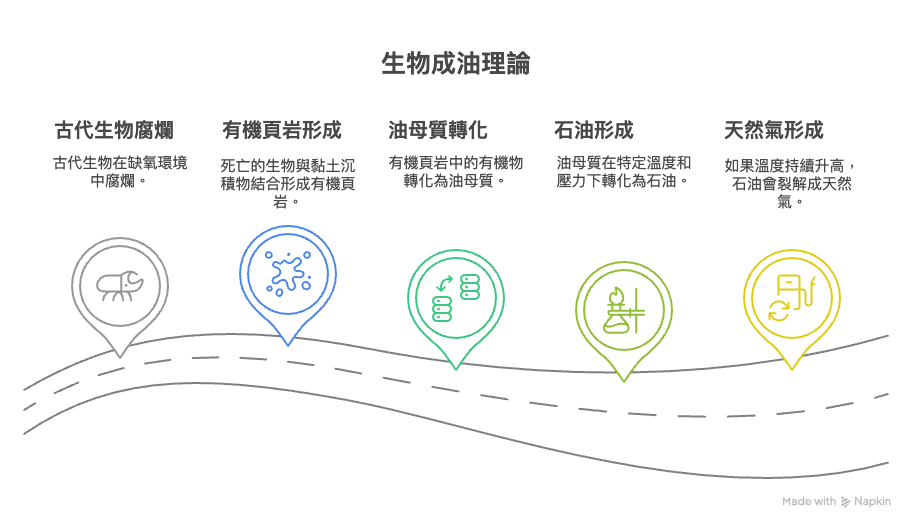石油是什麼?從成油理論看石油資源之起源
生物成油理論.非生物成油理論
石油
6/16/2025


石油是什麼?What is petroleum?
石油又稱原油,是一種天然存在且黏稠的黃黑色液態化學物質混合物,主要由碳氫化合物組成。它的形成是一個漫長而複雜的自然過程,主要有兩種理論:生物成油理論和非生物成油理論。
Petroleum, also called crude oil, is a natural liquid. It is thick and yellowish-black. Petroleum is mainly made of hydrocarbons. Its formation is a long and complex natural process. There are two main theories about how it forms: the fossil petroleum theory and the abiogenic petroleum origin theory.


二、生物成油理論 Fossil Petroleum
有機物來源與沉積 Organic Matter Source and Deposition
生物成油理論是目前最被廣泛接受的觀點。它認為,石油是由數百萬年前大量古代生物的遺骸經過漫長地質作用形成的。這些古生物,主要是浮游生物和藻類,在死亡後沉積於海洋或湖泊底部。
The fossil petroleum theory is the most widely accepted view today. It says petroleum forms from the remains of ancient organisms that lived millions of years ago. These organisms were mainly plankton and algae. When they died, their remains settled at the bottom of oceans or lakes.
要形成石油,這些有機物必須迅速被覆蓋在缺氧環境中,以避免被需氧細菌分解。這種厭氧環境多由泥沙或黏土覆蓋形成,使有機物得以保存。
To form petroleum, these organic materials must be quickly covered in an oxygen-poor environment. This prevents them from being broken down by oxygen-loving bacteria. Such anaerobic conditions are usually created when mud or clay covers the organic matter, helping preserve it.
油母質的形成 Kerogen Formation
隨著時間流逝,更多的有機物和沉積物累積,這些被深埋的有機成分在高溫高壓條件下發生化學變化,逐漸轉化成固態或蠟狀的物質,稱為油母質(Kerogen)。這是一種介於有機物與石油之間的過渡物質。
Over time, more organic matter and sediments build up. The buried organic material undergoes chemical changes under high temperature and pressure. It gradually turns into a solid or waxy substance called kerogen. Kerogen is a transition material between organic matter and petroleum.
油母質轉化為石油與天然氣 Convert into Petroleum and Natural Gas
當油母質繼續埋藏於地下更深處,受到更高溫度和壓力影響時,它會開始裂解,轉化為石油與天然氣。
As kerogen is buried deeper, higher temperature and pressure cause it to break down. This process forms petroleum and natural gas.
石油生成有一個特定的溫度範圍,稱為「油窗」(Oil Window),約在90℃到160℃之間。只有在這個溫度區間內,油母質才能有效轉化為石油。溫度過低,油母質無法裂解成油;溫度過高,石油會進一步裂解成天然氣,甚至石墨。
Petroleum forms only within a specific temperature range called the "oil window," about 90℃ to 160℃. Within this range, kerogen can convert into oil. If the temperature is too low, kerogen stays solid. If it is too high, oil breaks down further into natural gas or even graphite.
石油的運移與聚集 Migration and Accumulation
生成的石油因比周圍岩石和水輕,會往上滲透,移動到多孔且滲透性良好的儲油岩(如砂岩)中。這些石油會被上方不透水的頂蓋岩(如頁岩或鹽層)阻擋,形成圈閉結構,使石油聚集成油田,便於人類鑽探開採。
Since petroleum is lighter than surrounding rocks and water, it moves upward. It seeps into porous and permeable reservoir rocks, such as sandstone. Above these rocks are impermeable cap rocks, like shale or salt layers, which trap the petroleum. This creates a seal that forms an oil trap. Petroleum collects here, making it possible for humans to drill and extract it.


三、非生物成油理論 Abiogenic Petroleum Origin
理論背景與基本主張 Background and Basic Ideas
非生物成油理論由19世紀俄羅斯科學家提出,認為石油不是生物遺骸的產物,而是地球深部無機碳在高壓高溫條件下自然形成的碳氫化合物,這些油氣向上滲透至地殼儲層。
The abiogenic petroleum theory was proposed by Russian scientists in the 19th century. It suggests that petroleum is not made from ancient biological remains. Instead, it forms naturally from inorganic carbon deep inside the Earth under high pressure and temperature. These hydrocarbons then move upward into the Earth's crust reservoirs.
理論之爭議與限制 Controversies and Limitations
此理論支持者較少,因為它無法解釋絕大多數石油都集中在沉積岩層中,也難以說明石油中存在大量生物標誌物及同位素特徵。雖然非生物來源石油存在,但其商業開採量極小,對整體石油供應影響有限。
This theory has few supporters. It cannot explain why most petroleum is found in sedimentary rock layers. It also struggles to account for the many biological markers in petroleum, like steranes and gammacerane, and isotope signatures. Although abiogenic petroleum exists, its commercial production is very small and has little impact on overall oil supply.
四、結論 Conclusion
石油的形成是一個複雜且耗時的地質過程,需具備特定有機物來源、厭氧環境、適合的溫度與壓力,以及儲油與圈閉結構等多項條件。這些條件綜合造就了地球上珍貴的石油資源。
Petroleum formation is a complex and slow geological process. It requires specific organic sources, oxygen-poor environments, suitable temperature and pressure, and reservoir and trap structures. All these conditions together create the Earth's valuable petroleum resources.
這是我的學習筆記,有任何想法都歡迎留言與我分享!
Feel free to leave your thoughts and share them with me!
